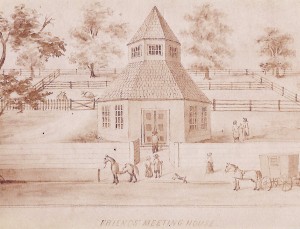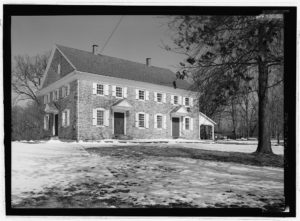 History of the Meeting House
History of the Meeting House
The history of the Meeting House includes a sail across the Atlantic, purchase of land from the Lenape, rebuild for gender equality and renovation for re-purposing.
1676 Burlington purchased
In 1676, representatives of the West Jersey Proprietors bought from the Lenape Nation the land where Burlington City is now and roughly 15 miles of land along the river in each direction.
1677 Meeting for Worship under sails
“Burlington, as a Friends’ settlement, is older than Philadelphia, and second only to Salem, in this part of the country. It was the ship Kent which in the year 1677 carried two hundred and thirty Friends from England, where they were suffering persecution for conscience’ sake.
True to their religious character immediate provisions were made for gatherings for worship. The sail of the ship Kent provided the first shelter.”
(Bulletin of the Friends Historical Association, Volumes 4-6).
1678 Burlington Monthly Meeting established
In these words Burlington Monthly Meeting was established:
“Since by the good Providence of god many friends with their families have transported themselves into this Province of West New Jersey, the said friends in those upper parts have found it needful according to our practice in the place wee came from to settle Monthly Meetings for the well ordering the affairs of the church it was agreed that accordingly it should be done and accordingly it was done the 15th of ye 5th Moth 1678.” {July 15, 1678. Click here to read more about the Julian Calendar}. (First page of Burlington Meeting records)
It appears that Burlington Friends met quarterly with Salem Friends until Burlington Quarterly Meeting was established in 1686.
Yearly Meeting was established in 1681 and held at the house of Thomas Gardner of Burlington and was held at Burlington until 1685, when the first session in Philadelphia was held. From then until 1760 the Yearly Meeting met alternately in the two cities, and since in the latter place.
1683 Burlington Meeting House
Friends met for worship in homes until a meetinghouse could be erected. One was started in 1683, hexagonal in design and constructed of brick, by Francis Collins, who was also building the courthouse. The meetinghouse was not ready for use until 1687. The hexagonal meetinghouse was the only place in Burlington for public worship for nearly twenty years. It was found to be very difficult to heat, with its high, incomplete roof, so that an addition was built to the front of it in 1696. With the years the membership increased until it was necessary to provide a larger house, and the present one was built in 1783 in front of the site of the hexagonal house.
1783 Burlington Meeting House

Buckingham Meeting House, Lahaska, Pa.
The first generations of Quaker immigrants adhered to a pattern of meeting established by the English Friends whereby men and women met together for worship in a single room and then separated for gender-specific business meetings, with the women retiring to a separate space. This arrangement required a room large enough for joint meetings and a second room that needed only to accommodate the adult female population. The 1783 meeting house was built in the style of the 1769 Buckingham (Lahaska, Pa.) Friends Meeting House – a symmetrically balanced, two-story, gable-roofed structure three bays deep and six bays across to include a two-cell, doubled arrangement that no longer treated the men’s and women’s sections as two disparate parts, but rather as separate yet identical parts of a whole structure. By the late eighteenth century, men and women began to meet on either side of a partition for worship and business, merely lowering the partition for the latter meetings. (https://www.nps.gov/nhl/find/statelists/pa/BuckinghamFriends.pdf and https://www.loc.gov/item/pa3601/)
The interior of the 1783 meetinghouse originally consisted of a single large room open to a balcony above. The interior could be divided by a retractable wood-paneled partition into two nearly equal-sized meetingrooms.
The seating capacity of the 1783 meetinghouse was 500 persons or more.
Much of the ironwork is original and was probably made in Burlington. Some of the window glass is iridescent and may have been in the older house. The framing of the Meeting House is the old mortise and tenon type construction with wooden pegs to hold the hand hewn 10″ x 12″ tie beams and the rafters together.
The porches on the front and southern end were added at a later time. An addition to the rear of the house was made about 1904 for kitchen and dining room for Quarterly Meeting and other occasions.
The property had been enclosed with a post and rail fence about 1698, replaced by a solid board fence, and finally by the present brick wall in 1807.
Relics of the olden days are the sconces (candle holders on the walls). The pine writing table was made in 1698 when, according to the Monthly Meeting minute, Isaac Merriott, and Benjamin Wheat were appointed “to provide a pine table for the use of the meeting.” for many years this table was used by the Clerk. It has been witness to many a Quaker wedding, used by the groom and bride when signing the certificate which consummates their marriage and which is signed by those present, family and friends, witnesses to the marriage.
1991-1995
In 1991, Burlington Monthly Meeting was laid down and the Meeting House was closed.
In 1994, a group of Philadelphia Yearly Meeting (PYM) Friends developed a plan to restore and reopen the Meeting House by building a conference center next to it for the use of PYM Quaker youth and families and for use by other Quaker and nonprofit organizations.
Half of the 1783 interior remains as a meetingroom. Of the other half, the ground floor is used as offices, the boardroom and the Hendrickson Room; the balcony as the Seminar Room.
The new Center for Conference and restored Meeting House were opened in 1995.
2008
Meeting for Worship resumed in the restored Meeting House 2008.
Burlington Meeting Records
http://archives.tricolib.brynmawr.edu/repositories/9/resources/5634
http://archives.tricolib.brynmawr.edu/repositories/9/resources/5396